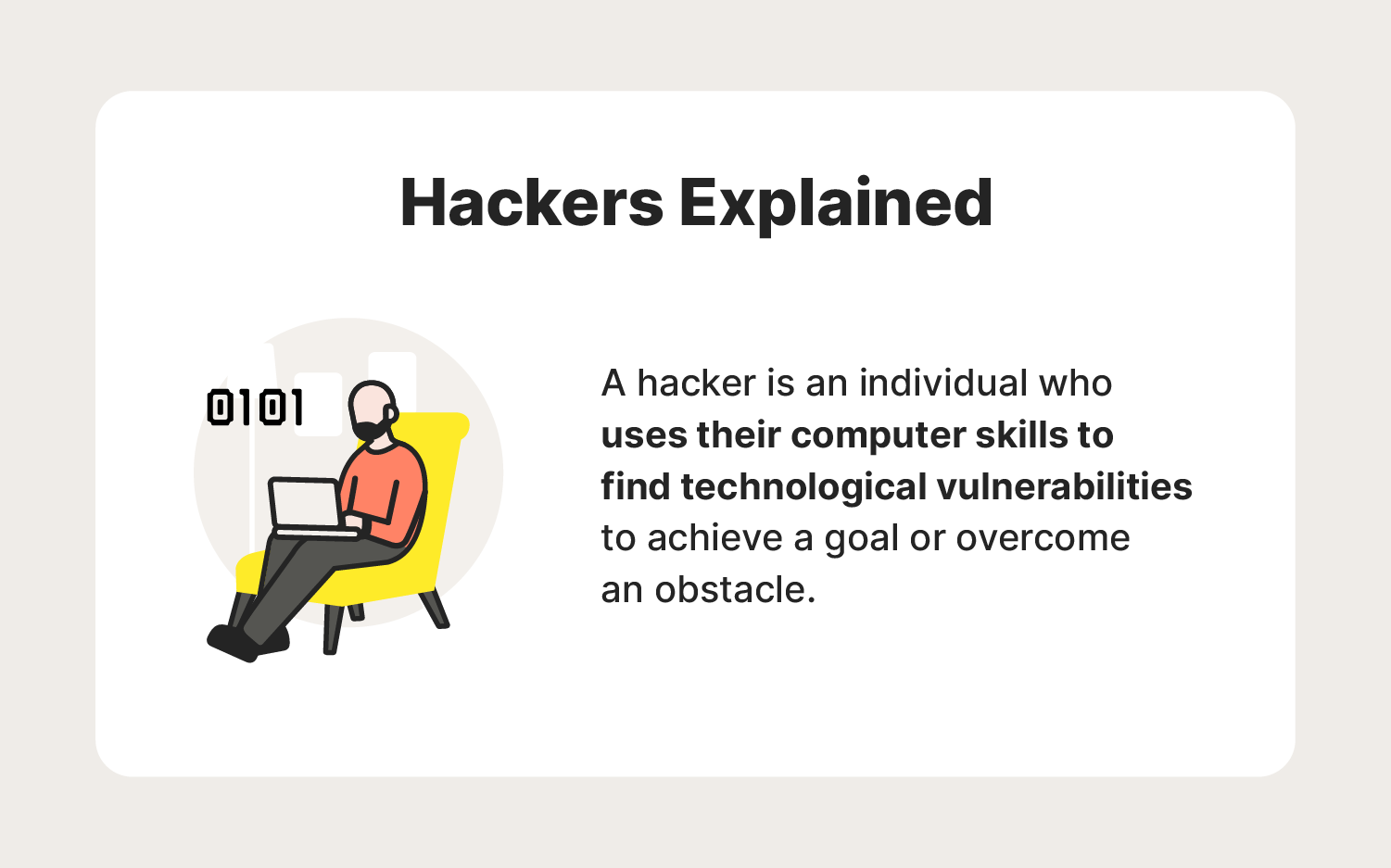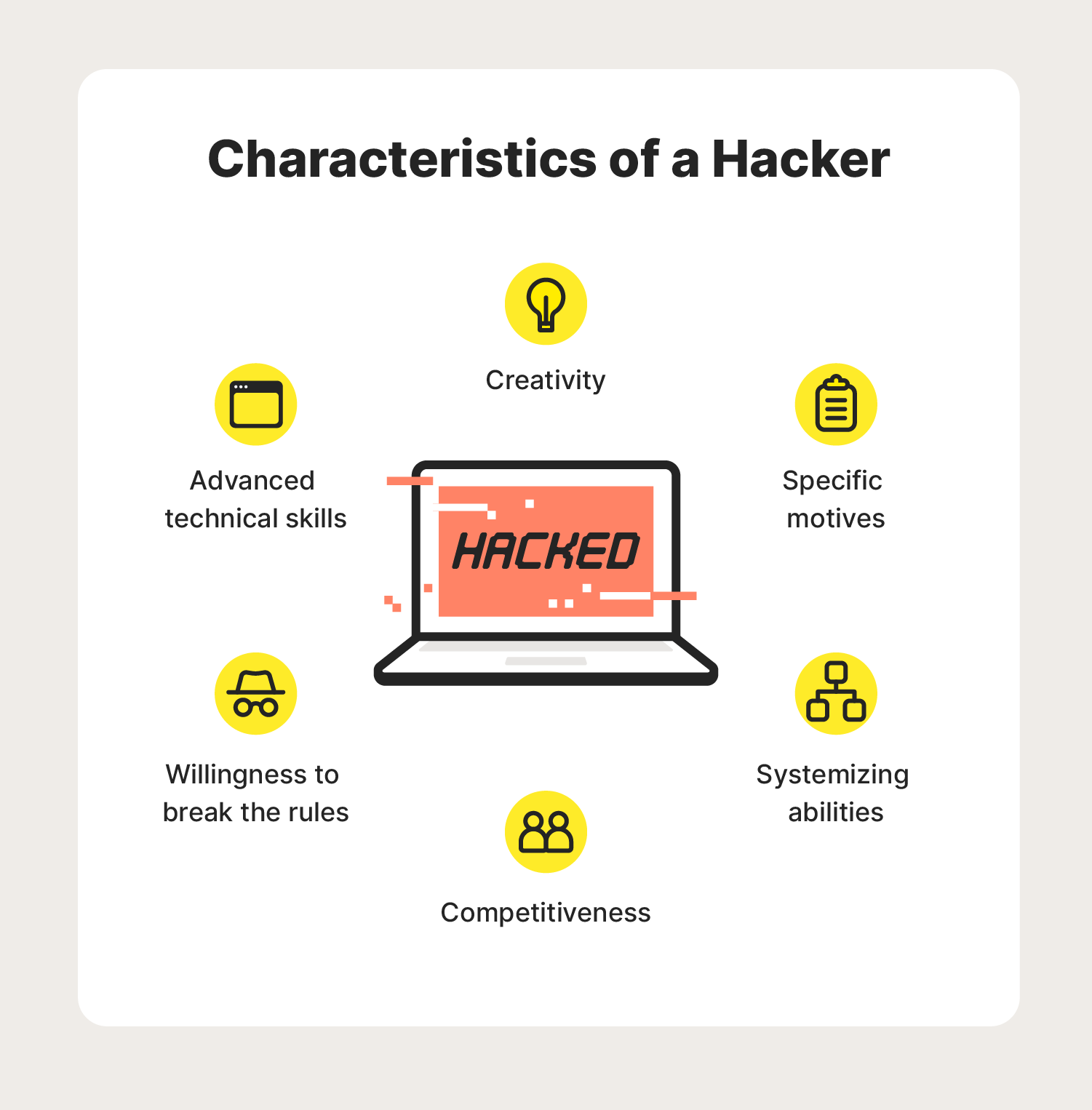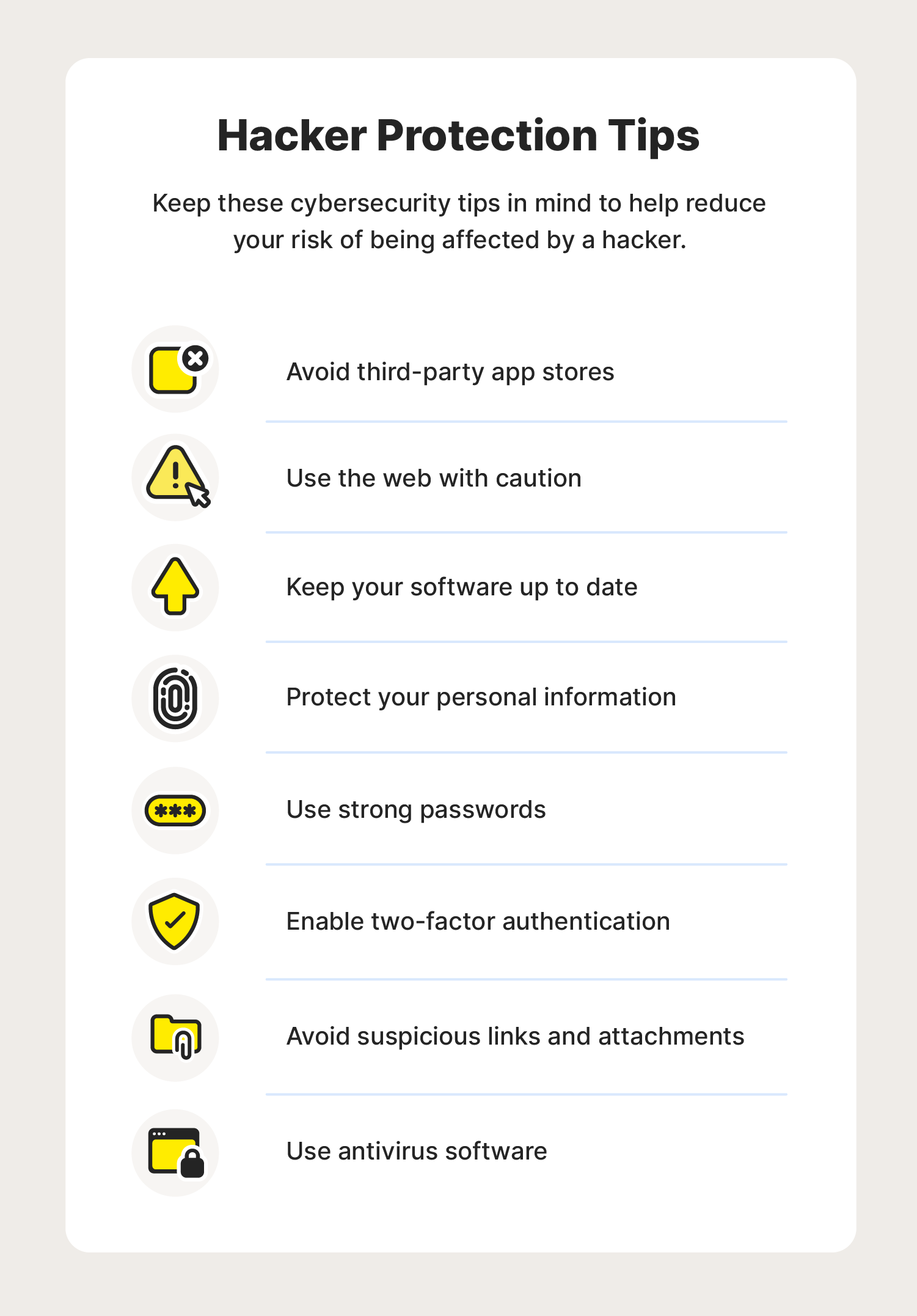What is a hacker (as explained in movie characters)? + how to protect yourself

What is a hacker?
A hacker is an individual who uses their computer skills to find vulnerabilities in existing technology to achieve a goal or overcome an obstacle. In some cases, hackers may use their expertise maliciously and gain unauthorized access to private data.
According to cybersecurity statistics, there are over 2,200 cyberattacks every single day. And behind almost every one is a hacker who leverages technical skills and social engineering tactics to take advantage of security vulnerabilities and internet users for their benefit.
Even though cyberattacks and hackers are prevalent on the internet, not all hackers have malicious intent. In fact, some professional hackers use their skills to help companies defend against criminal hackers and their associated cyberattacks.
Because of this, the term “hacker” does not always describe someone like the hackers portrayed in the movies (more on that later).

To help answer the question, “What is a hacker?” we’ll cover how hackers work, what makes a hacker a hacker, and the steps you can take to protect yourself.
How does hacking work?
Hackers can use hacking to their advantage by leveraging their technical skills to exploit flaws in cybersecurity defenses. This may include gaining unauthorized access to networks, phones, computers, IoT devices, software, and more.
They can do this by exploiting either technical or social weaknesses. A hacker may exploit a technical vulnerability by using their technical skills to inject a device with malware or find security flaws in software that allow them to gain unauthorized access to private data.
On the other hand, hackers may exploit social weaknesses by using social engineering techniques. For example, a hacker may trick an employee into giving out confidential information by impersonating their boss, otherwise known as a whaling attack.
No matter the hacking method, hackers can use their skills for a variety of reasons, from helping developers find security holes in their software to selling confidential information on the dark web.
The anatomy of a hacker

In the early days of the internet, stories of hackers typically involved clever teenagers breaking into the systems of well-known organizations to gain their 15 seconds of fame. But as the internet has advanced, so have hackers, leaving you to wonder, “What does a hacker look like?”
From iconic silver screen hackers like David Lightman and Elliot Alderson to the real-life hackers who make up the international hacking group Anonymous, it would be impossible to paint a picture that accurately represents the image of all hackers today.
But as diverse as these hackers may be, many of them do share similarities, including:
- Advanced technical skills: Most hackers possess advanced technical skills and knowledge of computer systems, allowing them to easily exploit software security flaws known as zero-day vulnerabilities and carry out targeted attacks.
- Specific motives: Whether the hacker is trying to make some extra cash, exploit injustices, or simply catch a thrill, hackers often have a specific motivation for their hacking efforts.
- Creativity: In some cases, successfully carrying out a hacking attack may require some out-of-the-box thinking, be it coming up with a unique way to bypass a password or creating different types of phishing emails.
- Willingness to break the rules: While not all forms of hacking are illegal, some hacking activities can involve breaking the law or invading people's privacy.
- Systemizing abilities: Systemizing is the ability to figure out how certain systems work and the ability to build them on your own. This skill is extremely useful for hackers, helping them understand advanced computer systems and find ways to break into them.
- Competitiveness: Because hackers are often competing against technology that was created to prevent hacking, most hackers have a competitive spirit that motivates them to outsmart obstacles that were put in place to stop them.
If a hacker possesses these skills, it is then up to them what type of hacker they want to be. Continue reading to learn more about the different types of computer hackers sneaking through the internet today.
What are the different types of hackers?

Now that you’ve cracked the code on how hackers hack, it's time to look at the different types of hackers sitting behind their computers. While some may use their skills for good, others take a much more malicious approach. Some of the most common types of hackers include:
- Threat actors: If you close your eyes and picture a hacker from a movie, you’re most likely thinking of a threat actor. Formally known as black hat hackers, threat actors use their skills to break into systems, networks, and devices with malicious intent. Whether they're making money off ransomware or stealing someone’s identity, threat actors use their skills for personal gain without regard for the law or others.
- Ethical hackers: If there was a superhero movie about hackers, the ethical hackers would be the ones saving the day. Formerly known as white hat hackers, ethical hackers use their hacking skills for good, spotting security flaws to help cybersecurity experts make the necessary changes to help prevent criminal hackers from exploiting them in the future.
- Red hat hackers: Also known as vigilante hackers, red hat hackers also use their skills for good, doing whatever it takes to take down a threat actor, even if it means breaking a few rules.
- Gray hat hackers: As the name suggests, the morals of a gray hat hacker lie in a bit of an ethical gray area. While they usually aren’t malicious, gray hat hackers may hack into systems for fun without proper authorization. Once the hacker gains access to their desired target, they may alert the owners of the security flaws or even offer to fix them.
- Green hat hackers: Green hat hackers are the new kids on the block, with little to no hacking experience. But these hackers don’t let their lack of knowledge stop them from getting their feet wet in the world of hacking. Because green hat hackers often don’t know what they’re doing, they may accidentally do some damage, whether they meant to or not.
- Blue hat hackers: Blue hat hackers are kind of like ethical hackers, except they are given access to software in order to test it for security flaws before a business commits to using it. This helps businesses avoid settling on a new piece of technology that could be susceptible to threat actors.
- Script kiddies: Script kiddies are amateur hackers that take advantage of pre-written scripts and computer hacking software to carry out their hacking endeavors. Unlike a green hat hacker who attempts to do the hacking on their own, script kiddies take a lazier approach and ride the coattails of other hackers.
- Hacktivists: These types of hackers use their hacking expertise to try to influence political change. They may do this by exposing information such as private communications and photos or by drawing attention to a cause they believe in.
As you can see, not all hackers are the ones you see in the movies. From affecting political change to helping software companies strengthen their security, hackers can use their skills in plenty of ways.
Common hacking techniques: 11 to watch out for
Be it a carefully crafted piece of ransomware or an elaborate smishing text, hackers can have a vast set of hacking methods up their sleeves. Some of the most common hacking techniques to watch out for include:
- Phishing emails: Hackers often use phishing emails to trick you into giving up personal information they can use to their advantage. Examples of these emails include messages pretending to be from a customer service representative or a coworker.
- Malware: Also known as malicious software, hackers use malware to help steal information or damage others’ devices. There are many different types of malware, from spyware to botnets.
- Ransomware: As the name suggests, this form of malware infects your device and bombards your screen with a ransom note. A popular example of this was CryptoLocker, which caught global attention after encrypting innocent users’ files to scare them into paying a ransom.
- Trojans: Trojans are a form of malware that is often disguised as legitimate applications or files to trick users into downloading them willingly. Once installed, Trojan applications can wreak havoc on your device and privacy.
- Brute force attacks: A brute force attack is when a hacker uses trial and error to attempt to gain unauthorized access to computer systems or online accounts. An example of this is testing millions of login credentials in hopes that they’ll gain access to someone’s private account.
- Distributed denial-of-service (DDoS) attacks: A DDoS attack is when a hacker tries to crash a website by flooding it with an absurd amount of traffic. They can do this by using an army of remotely controlled computers known as botnets.
- Smishing: Smishing, a hybrid of phishing and SMS, is a type of phishing attack that targets mobile phones via text message. Like their email-based counterparts, smishing texts often include requests for personal information and suspicious links that link to malicious websites.
- Domain Name System (DNS) spoofing: DNS spoofing is an attack in which hackers redirect internet traffic to a malicious website that impersonates its legitimate destination. Once the users are redirected to their unsafe site, the hacker may use it to install worms and other types of malware.
- Website spoofing: Sometimes referred to as domain spoofing, website spoofing is a technique used by hackers to create fraudulent websites that impersonate legitimate companies. Once users visit their spoofed site, they may infect your device with malware or steal your credit card information or login credentials.
- Structured Query Language (SQL) injection: SQL injection is a hacking method in which hackers may gain back-end access to databases of private information such as user data and login credentials.
- Keyloggers: A keylogger is a form of hardware or software that captures and records a user's keystrokes. Hackers use keyloggers to spy on people's internet activity, tracking everything from passwords to account numbers. By using a keylogger, a hacker can quickly capture the information they need to steal your identity.
As you can see, hackers have developed sneaky ways to exploit security flaws and trick innocent internet users into giving them what they want. Fortunately, you can reduce the risk of these attacks by practicing good cyber hygiene habits.
How to protect against hackers: 8 cybersecurity tips

With so many hacking methods at hackers’ disposal, you may wonder what you can do to stay safe. Luckily, there are some cybersecurity tips you can follow to help reduce the risk of being affected by a malicious hacker. To help protect against hacking, follow these tips:
- Avoid third-party app stores: Whenever you download new applications for your device, be sure to stick to trusted app stores and websites, as third-party app stores can be riddled with malware in disguise.
- Use the web with caution: From sending emails to online shopping, always do your best to use common sense and caution when using the internet. By staying vigilant and thinking before you click, you can reduce the risk of falling for hacking methods like phishing emails or spoofed websites.
- Keep your software up to date: Because threat actors may target security vulnerabilities in outdated software, it's important to always keep your operating system and other pieces of software up to date. This can ensure you have the latest software updates that work to help keep hackers at bay.
- Protect your personal information: Wherever you are online, always think twice before sharing any personal information. By safeguarding your personal information, you can reduce the risk of your private info getting into the hands of a hacker.
- Use strong passwords: No matter what the account or device is, try to create a hack-proof password. After all, a strong password could be the hacking prevention measure that keeps a hacker from breaking into one of your accounts.
- Enable two-factor authentication (2FA): By enabling 2FA wherever you can, you’re putting an additional layer of protection between yourself and hackers. That way, if a hacker gains access to your login credentials for one of your accounts, they still won’t be able to access it.
- Avoid suspicious links and attachments: Whenever you’re accessing a new website or opening an email, keep a close eye out for any suspicious links or attachments, as they could’ve been carefully placed by a hacker trying to take advantage of you.
- Use antivirus software: Lastly, installing antivirus software is a great way to add a layer of security to your device that can help reduce the risk of hackers accessing your information and the associated damage from their attacks. It’s smart to consider trusted security software like Norton 360 Deluxe to help protect your devices and online privacy.
With the question, “What is a hacker?” now answered, you can use your devices with confidence, knowing you’ve done what you can to help reduce the risk of an attack. But hackers aren’t the only thing to be aware of. To help stay Cyber Safe, be sure to take all the steps necessary to protect yourself online.
FAQs about hackers
Still curious about hackers? Read through the answers to these frequently asked questions.
What is ethical hacking?
Ethical hacking is when a hacker is authorized to attempt to gain unauthorized access to a device, network, or application. This form of hacking can help companies pinpoint and fix security flaws that may be targeted by malicious hackers.
What do hackers use to hack?
Hackers can use a variety of hacking tools and techniques to help them in their exploits, including phishing emails, ransomware, Trojans, botnets, and more.
What devices can hackers hack?
Hackers can use their hacking skills to target a wide range of devices, including computers, smartphones, gaming consoles, IoT devices, and more.
Editorial note: Our articles provide educational information for you. Our offerings may not cover or protect against every type of crime, fraud, or threat we write about. Our goal is to increase awareness about Cyber Safety. Please review complete Terms during enrollment or setup. Remember that no one can prevent all identity theft or cybercrime, and that LifeLock does not monitor all transactions at all businesses. The Norton and LifeLock brands are part of Gen Digital Inc.



Want more?
Follow us for all the latest news, tips and updates.